
The Manhattan Project was a program of research and development undertaken during World War II to produce the first nuclear weapons. It was led by the United States in collaboration with the United Kingdom and Canada. From 1942 to 1946, the project was under the direction of Major General Leslie Groves of the U.S. Army Corps of Engineers. Nuclear physicist J. Robert Oppenheimer was the director of the Los Alamos Laboratory that designed the bombs. The Army program was designated the Manhattan District, as its first headquarters were in Manhattan; the name gradually superseded the official codename, Development of Substitute Materials, for the entire project. The project absorbed its earlier British counterpart, Tube Alloys. The Manhattan Project employed nearly 130,000 people at its peak and cost nearly US$2 billion, over 80 percent of which was for building and operating the plants that produced the fissile material. Research and production took place at more than 30 sites across the US, the UK, and Canada.

Los Alamos National Laboratory is one of the sixteen research and development laboratories of the United States Department of Energy (DOE), located a short distance northwest of Santa Fe, New Mexico, in the American southwest. Best known for its central role in helping develop the first atomic bomb, LANL is one of the world's largest and most advanced scientific institutions.
Lawrence Livermore National Laboratory (LLNL) is a federally funded research and development center in Livermore, California, United States. Originally established in 1952, the laboratory now is sponsored by the United States Department of Energy and administered privately by Lawrence Livermore National Security, LLC.
The LANL Research Library is a research library at Los Alamos National Laboratory. It contains a substantial collection of books, journals, databases, patents along with technical reports. Additionally it offers literature searching, training, and outreach services. The library has a research and development (R&D) component, which works in areas such as open archives, recommendation systems, emergency response information systems, and discovery systems. Its stated mission is to deliver effective and responsive knowledge services, thereby connecting people with information, technology, and resources. Its stated purpose (vision) is essential knowledge services for national security sciences.
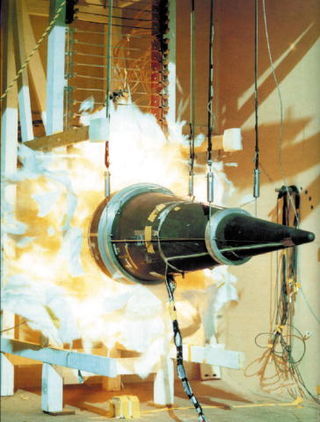
Stockpile stewardship refers to the United States program of reliability testing and maintenance of its nuclear weapons without the use of nuclear testing.

The Metallurgical Laboratory was a scientific laboratory at the University of Chicago that was established in February 1942 to study and use the newly discovered chemical element plutonium. It researched plutonium's chemistry and metallurgy, designed the world's first nuclear reactors to produce it, and developed chemical processes to separate it from other elements. In August 1942 the lab's chemical section was the first to chemically separate a weighable sample of plutonium, and on 2 December 1942, the Met Lab produced the first controlled nuclear chain reaction, in the reactor Chicago Pile-1, which was constructed under the stands of the university's old football stadium, Stagg Field.
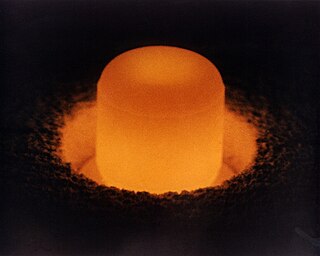
Plutonium-238 is a radioactive isotope of plutonium that has a half-life of 87.7 years.
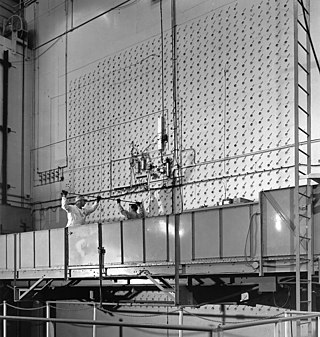
The X-10 Graphite Reactor is a decommissioned nuclear reactor at Oak Ridge National Laboratory in Oak Ridge, Tennessee. Formerly known as the Clinton Pile and X-10 Pile, it was the world's second artificial nuclear reactor, and the first designed and built for continuous operation. It was built during World War II as part of the Manhattan Project.
Los Alamos National Security, LLC was a private limited liability company (LLC) formed by the University of California, Bechtel, BWX Technologies, and URS Energy and Construction. From its creation until November 1, 2018, it operated Los Alamos National Laboratory (LANL) for the Department of Energy and the National Nuclear Security Administration. It took over direct management and operation of the Los Alamos National Laboratory from the University of California on June 1, 2006. It was based in Los Alamos, New Mexico. Operation of Los Alamos National Laboratory are now overseen by Triad National Security.
The Reliable Replacement Warhead (RRW) was a proposed new American nuclear warhead design and bomb family that was intended to be simple, reliable and to provide a long-lasting, low-maintenance future nuclear force for the United States. Initiated by the United States Congress in 2004, it became a centerpiece of the plans of the National Nuclear Security Administration (NNSA) to remake the nuclear weapons complex.

The W89 was an American thermonuclear warhead design intended for use on the AGM-131 SRAM II air to ground nuclear missile and the UUM-125 Sea Lance anti-submarine missile.
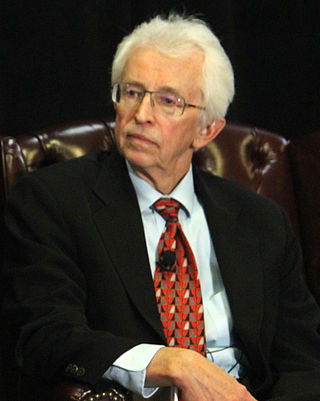
Siegfried S. Hecker is an American metallurgist and nuclear scientist. He served as Director of the Los Alamos National Laboratory from 1986 to 1997 and is now affiliated with Stanford University, where he is research professor emeritus in the Department of Management Science and Engineering in the School of Engineering, and senior fellow emeritus at the Freeman Spogli Institute for International Studies. During this time, he was also elected a member of the National Academy of Engineering (1988) for outstanding research on plutonium and the forming of materials, and for leadership in developing energy and weapons systems.
The Dual-Axis Radiographic Hydrodynamic Test Facility (DARHT) is a facility at Los Alamos National Laboratory which is part of the Department of Energy's stockpile stewardship program. It uses two large X-ray machines to record three-dimensional interior images of materials. In most experiments, materials undergo hydrodynamic shock to simulate the implosion process in nuclear bombs and/or the effects of severe hydrodynamic stress. The tests are described as "full-scale mockups of the events that trigger the nuclear detonation". The powerful pulsed X-ray beams allow for an ultra-fast motion picture to be constructed showing the details of the process being studied in three dimensions. The tests are compared with computer simulations to help improve the accuracy of the computer codes. Such testing falls under the category of sub-critical testing.
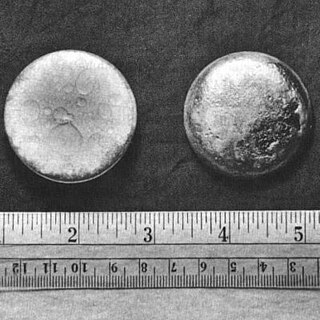
Plutonium is a chemical element; it has symbol Pu and atomic number 94. It is an actinide metal of silvery-gray appearance that tarnishes when exposed to air, and forms a dull coating when oxidized. The element normally exhibits six allotropes and four oxidation states. It reacts with carbon, halogens, nitrogen, silicon, and hydrogen. When exposed to moist air, it forms oxides and hydrides that can expand the sample up to 70% in volume, which in turn flake off as a powder that is pyrophoric. It is radioactive and can accumulate in bones, which makes the handling of plutonium dangerous.

Linton Forrestall Brooks is an American government official who served as the Under Secretary of Energy for Nuclear Security from 2002 to 2007.
Fogbank is a code name given to a secret material used in the W76, W78 and W88 nuclear warheads that are part of the United States nuclear arsenal. The process to create Fogbank was lost by 2000, when it was needed for the refurbishment of old warheads. Fogbank was then reverse engineered by the National Nuclear Security Administration (NNSA) over five years and at the cost of tens of millions of dollars.
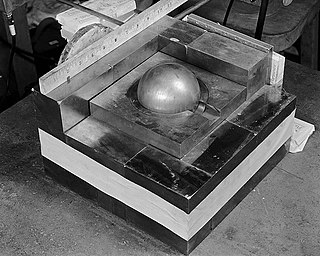
In nuclear weapon design, the pit is the core of an implosion nuclear weapon, consisting of fissile material and any neutron reflector or tamper bonded to it. Some weapons tested during the 1950s used pits made with uranium-235 alone, or as a composite with plutonium. All-plutonium pits are the smallest in diameter and have been the standard since the early 1960s. The pit is named after the hard core found in stonefruit such as peaches and apricots.

Charles F. McMillan is an American nuclear physicist and served as the 10th director of the Los Alamos National Laboratory. His appointment was effective June 1, 2011. He succeeded Michael R. Anastasio. On September 5, 2017, McMillan announced he would be leaving the director position at the end of the year.
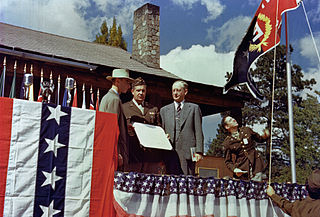
The Los Alamos Laboratory, also known as Project Y, was a secret laboratory established by the Manhattan Project and operated by the University of California during World War II. Its mission was to design and build the first atomic bombs. Robert Oppenheimer was its first director, serving from 1943 to December 1945, when he was succeeded by Norris Bradbury. In order to enable scientists to freely discuss their work while preserving security, the laboratory was located on the isolated Pajarito Plateau in Northern New Mexico. The wartime laboratory occupied buildings that had once been part of the Los Alamos Ranch School.
Dana Dattelbaum is an American physicist and scientist at Los Alamos National Laboratory. She leads NNSA’s Dynamic Materials Properties portfolio at LANL, which provides experimental data, platforms and diagnostics for materials behaviors relevant to nuclear weapons performance, ranging from plutonium to high explosives.














